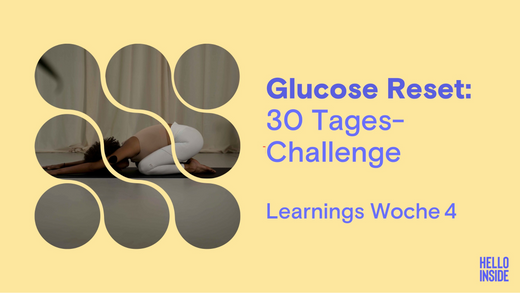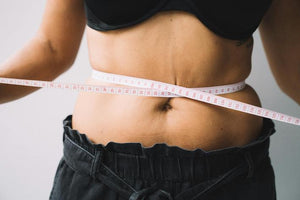The Glucose Reset Challenge is officially over—and the insights from the past four weeks couldn't be more exciting! 🎉 Our community has been testing hard, optimizing meals, incorporating exercise, and developing new routines to better understand their blood sugar.
But what happens now? The real challenge is only just beginning: How can the insights gained be integrated into everyday life in the long term? Because sustainable health is not achieved through short-term experiments – but through long-term changes.
In this article you will learn:
- The most important learnings from week 4 of the challenge
- Which blood sugar hacks really work – scientifically explained
- How you can consolidate your successes and benefit from the insights in the long term
Key findings of the challenge
1. Meal combinations have a huge impact on blood sugar
Our participants were able to experience firsthand how fiber, protein, and healthy fats help minimize blood sugar spikes and keep energy levels stable.
Why is this important?
Studies show that high blood sugar spikes can impair insulin sensitivity and, in the long term, increase the risk of type 2 diabetes and cardiovascular disease. A study in the American Journal of Clinical Nutrition (2020) confirms that meals high in protein and healthy fat stabilize postprandial (after eating) blood sugar levels .
Which combinations have proven successful?
✅ Snacks with nuts or yogurt – Healthy fats and proteins slow down glucose absorption.
✅ More vegetables & protein sources such as lentils or chicken – fiber ensures slower sugar absorption.
✅ Replace white bread with whole grain & choose carbohydrates more consciously – fewer rapid sugar peaks.
2. Exercise after eating helps stabilize blood sugar
Many challenge participants observed that a short walk after eating smoothed out the blood sugar curve.
The science behind it:
A meta-analysis from Sports Medicine (2022) shows that just 10–15 minutes of walking after a meal can lower blood sugar by up to 30% . The reason: exercise activates the GLUT-4 transporters in muscle cells , which absorb glucose directly from the blood—independently of insulin.
Practical tips:
✅ Take a 10-minute walk after each meal – that’s enough!
✅ Test different exercise intensities – from light walking to short HIIT sessions.
3. Stress & sleep have a huge impact on blood sugar
Many participants noticed that poor sleep and stress had a significant impact on their blood sugar levels – often even more than diet!
🔹 Why does this happen?
Cortisol & blood sugar: Stress increases cortisol levels, which in turn reduces insulin sensitivity. A study from Diabetes Care (2019) shows that chronic stress increases the risk of insulin-resistant conditions and, in the long term, even type 2 diabetes.
Sleep & Glucose Control: Lack of sleep leads to an increased release of ghrelin (the “hunger hormone”) and a reduction in leptin (the “satiety hormone”), which in turn leads to cravings and elevated blood sugar levels.
🔹 What helps?
Establish an evening routine: At least 7–9 hours of sleep per night.
Use breathing exercises or meditation during stressful periods to lower cortisol levels.
Avoid blue light and don’t eat anything 3 hours before going to bed.
4. The cycle influences insulin sensitivity
Female participants in particular reported that their blood sugar levels changed noticeably depending on the phase of their cycle.
🔹 The science behind it:
A study in The Journal of Clinical Endocrinology & Metabolism (2021) confirms that insulin sensitivity decreases during the luteal phase (second half of the cycle) , which can lead to higher blood sugar levels. This is due to altered hormone levels of progesterone and estrogen .
🔹 What helps?
✅ Pay particular attention to exercise in the second half of your cycle to compensate for insulin spikes.
✅ Prioritize meals with more protein & healthy fats to minimize blood sugar fluctuations.
💡 Your next step: Consolidate your successes & benefit in the long term
Now is the perfect time to sustainably integrate the insights you've gained into your daily life. Here are three effective strategies:
1️⃣ Create routines & continue proven strategies
✔️ Plan meals in advance & stick to blood sugar-friendly combinations.
✔️ Establish a regular evening routine for better sleep and reduced stress.
✔️ Get active every day after meals – even small steps count!
2️⃣ Stay flexible & keep experimenting
✔️ Your body is changing – be open to new approaches.
✔️ Continue tracking your meals & symptoms in the Hello Inside app to identify individual patterns.
3️⃣ Use self-reflection & stay motivated in the long term
✔️ Regularly note how you feel to identify patterns.
✔️ Connect with the Hello Inside community to share experiences and tips.
🌱 What's next? Your spring check-in!
After the challenge, it's time for the next check-in! 💡 With Hello Inside Premium, you can continue to track your progress and delve deeper into your metabolic health.
📊 New sensors to check your progress
🧪 Personalized recommendations & new coaching content
💛 Motivation & support for sustainable health




